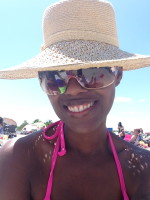It’s not everyday you get to witness a total solar eclipse. But, you may able to catch a glimpse of the next one on Monday, August 21, 2017.
A total solar eclipse happens when the Moon passes between the Earth and the Sun thereby creating a shadow. The National Weather Service reports that the path will span from Salem, Oregon to Charleston, South Carolina. Observers outside this path will still see a partial solar eclipse where the moon covers part of the sun’s disk.
It’s actually cool when you think about. It goes from daylight to darkness in a matter of minutes during normal daylight hours. The last time I experienced an event like this was when I was a foreign exchange student in Spain back on August 11, 1999.
My classmates and I took a field trip to one of the museums in the southern part of the country. We all stood outside to watch the Sun, Earth, and Moon move into alignment with one another. It was amazing to see such a phenomenon. But, I had no idea it could be damaging the eyes.
That said, if you’re planning on viewing the solar eclipse, here are some safety tips to keep in mind.
Total Solar Eclipse Safety Tips
While it’s ok to look directly at the Sun during the total phase of the solar eclipse with naked eyes, you can damage your retina when the Moon isn’t entirely blocking the Sun.
Use special-purpose solar filters like eclipse glasses or hand-held solar viewers to look at the uneclipsed or partially eclipsed Sun.
There are four manufacturers that have certified eclipse glasses and handheld solar viewers that meet the ISO 12312-2 international standard for such products. These include Rainbow Symphony, American Paper Optics, Thousand Oaks Optical, and TSE 17. There are also special eclipse glasses for kids. See a complete list of other brands here.
How to Correctly Use Solar Glasses and Filters
1. Make sure that the solar filter isn’t scratched or damaged. If so, don’t use it. Follow directions on the package.
2. Supervise children using solar filters.
3. Use solar viewer or eclipse glasses before looking directly into the Sun. Don’t remove it while looking at the Sun.
4. Avoid using an unfiltered camera, telescope, binoculars. Also avoid using them in conjunction with eclipse glasses or a hand-held solar viewer. This can damage the filter and enter your eye(s), causing serious injury.
How to Create a Pinhole Projection
You can also view the partially eclipsed Sun through a pinhole projection. Stretch out your arms and slightly open your fingers, placing one hand over the other. Look at your hands while your back is to the sun. Then look at the shadow of your hands on the ground. The spaces between your fingers will create a grid of small images on the ground. You should see the partial phase of the eclipse.
When is it OK to look Directly at the Eclipse
When the Sun is completely covered by the Moon, you can remove your glasses or filter and safely look at the eclipse. However, when the Sun begins to reappear, put your eclipse classes or solar filter to glance at the remaining partial phase.
Unfortunately some people will not be able to view the total eclipse. Folks outside of the path between Salem, Oregon to Charleston, South Carolina will only see a partial eclipse. Happy viewing!
Safety information courtesy of NASA












